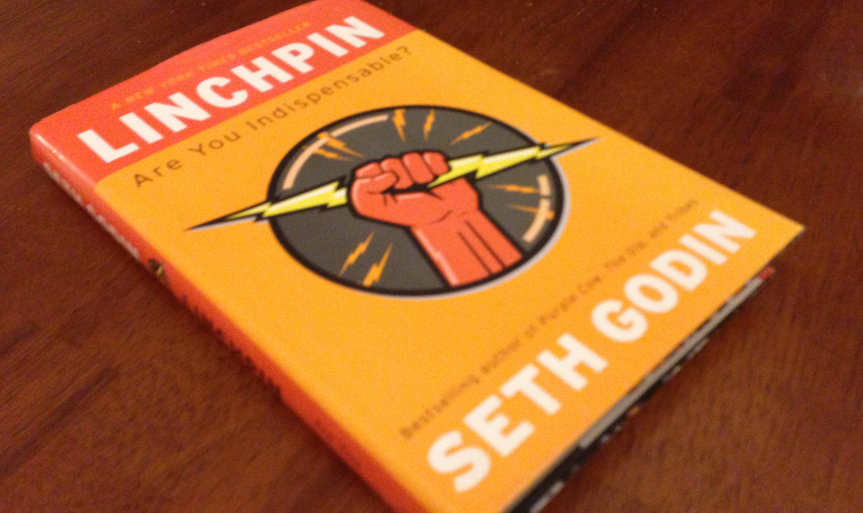Originally posted here.
I’m unsure what took me so long to finally get around to reading Seth Godin’s Linchpin. While it seems utterly ridiculous, I feel like it was something that I was meant to read at this point in my life; I’m glad that I only read it now, in the throes of (widespread?) change across the public service. (I fully recognize that the idea of change is subjective and there are some skeptics about the whole issue, but humour me, ok?) I totally think that it should be required reading for any public servant. Seriously.
At first glance it doesn’t seem entirely applicable because it talks about art – the creation of art and giving gifts (your art). But what Godin is really talking about is emotional labour, work that requires/allows you to put yourself into it (rather than be automated – like an assembly line). Giving your art to someone else (through a personal interaction, going above and beyond, etc.) is viewed as a gift because you don’t expect anything in return, you do it simply because you want to create something that matters (i.e. a meaningful connection). In creating and giving art, and receiving little to nothing in return, you end up creating a bond with the recipient.
By creating and sharing art, you are becoming a linchpin. To Godin, this means “the essential building blocks of tomorrow’s high-value organizations. They don’t bring capital or expensive machinery, nor do they blindly follow instructions and merely contribute labour. Linchpins are indispensable, the driving force of our future.” In the public service, these would be your “innovators”, and chances are that you know one. But, in order for larger change to happen, we all need to become linchpins.
Godin points to a shift happening in relation to human resource management, shifting the odds in favour of the linchpins. But the public service has yet to understand and acknowledge this shift. Currently, within the public service, we largely want to hire people that already have the skills – learnable skills – to fill a job. What we have yet to fully realize is the importance of being a highly networked person that is able to connect the dots across the system. And yet, these skills are becoming more and more important to how we do business, and in failing to acknowledge these abilities, we risk being left behind. Godin explains the shift from a workplace that is:
Keep your head down, follow instructions, show up on time, work hard, suck it up; to one that is: Be remarkable, be generous, create art, make judgment calls, connect people and ideas.
What’s interesting about the idea of a linchpin, is the misconception that linchpins work outside the structures. Rather, they prefer to work within the structures, at the edges, because this creates guidelines for expectations, but they can also push against them. Most importantly though, it’s these boundaries that allow a linchpin to ship (deliver). A linchpin, or anyone for that matter, is completely useless if they can’t ship and deliver things. But delivering things in the public service can be difficult. Godin explains two challenges to shipping and one reason it’s so difficult:
Challenges: Thrashing, Coordination
Reason: The Resistance
Thrashing refers to the brainstorming and tweaks we make to a project as it progresses. There are two times thrashing can occur: the beginning or the end or a project. In the public service, we thrash A LOT at the end, which is when Godin says amateurs thrash. This happens because more and more people are becoming involved in the project (aka all those approval levels). If you thrash early on and can nail down what the purpose is, etc. then as the project progresses, fewer changes will be required and the likelihood of shipping on time increases.
Coordination is pretty straightforward: the more people you try to coordinate, the more difficult it becomes, leading to delays. To combat this, there are two options: limit the number of people permitted to thrash (which is more important: delivering a surprisingly good project on time or a mediocre project late?), or appoint a linchpin to run it (there is one person making decisions).
The Resistance is your “lizard brain”, where you take all the safe actions and care what everyone else thinks because the approval of the tribe/team is essential to survival. The lizard brain is the reason people don’t create art and have problems shipping. A particularly enjoyable quote is “the resistance is the voice in your head telling you to use bullets in your PowerPoint slides, because that’s what the boss wants.” Amen.
The lizard brain is something we see all the time in the public service; it is creating phantom rules and policies so processes and decisions are predictable, it’s creating committees for things instead of taking action, it’s criticizing people who do things differently (for fear of having to adopt a new approach).
Being a linchpin is a choice. Becoming indispensable is a choice. It is a conscious decision to come in to work and to create and give art. It will be a hard choice and the transition of becoming a linchpin will be messy and uncomfortable. As Godin says, there is no map to do this. There is no handbook, there are no rules. You have to create them.
So, be indispensable, be a linchpin.





Leave a Reply
You must be logged in to post a comment.